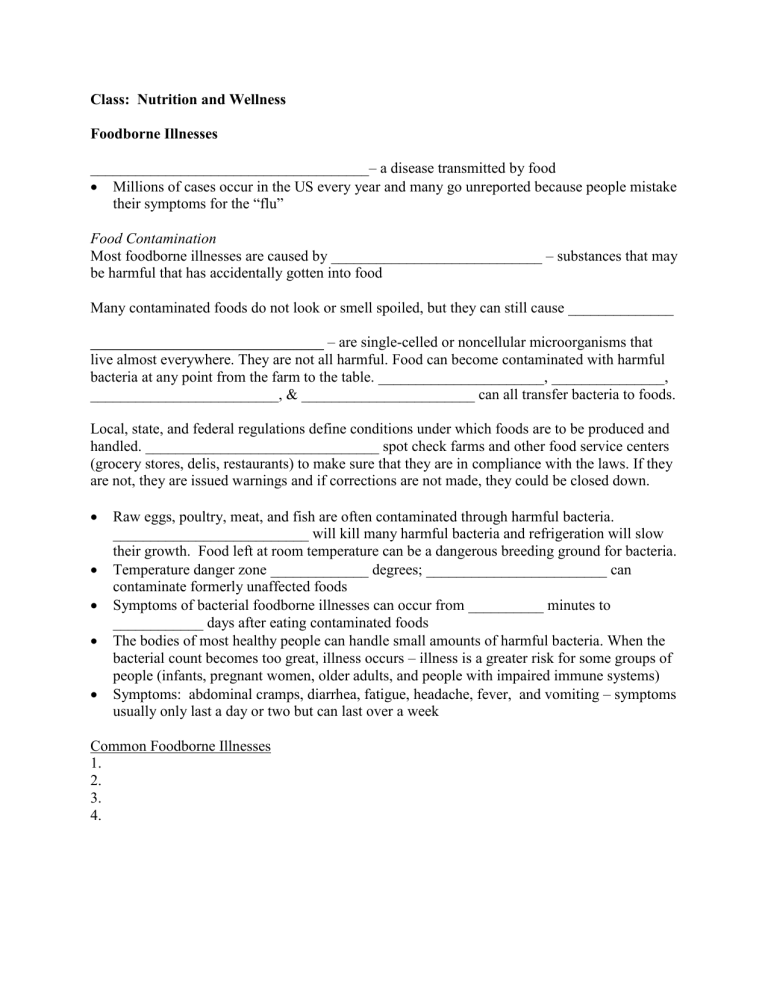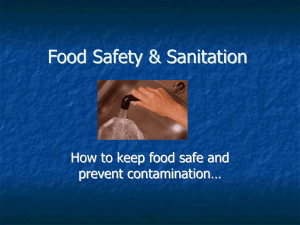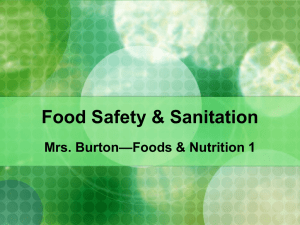Class: Nutrition and Wellness

Class: Nutrition and Wellness
Foodborne Illnesses
_____________________________________– a disease transmitted by food
Millions of cases occur in the US every year and many go unreported because people mistake their symptoms for the “flu”
Food Contamination
Most foodborne illnesses are caused by ____________________________ – substances that may be harmful that has accidentally gotten into food
Many contaminated foods do not look or smell spoiled, but they can still cause ______________
_______________________________ – are single-celled or noncellular microorganisms that live almost everywhere. They are not all harmful. Food can become contaminated with harmful bacteria at any point from the farm to the table. ______________________, _______________,
_________________________, & _______________________ can all transfer bacteria to foods.
Local, state, and federal regulations define conditions under which foods are to be produced and handled. _______________________________ spot check farms and other food service centers
(grocery stores, delis, restaurants) to make sure that they are in compliance with the laws. If they are not, they are issued warnings and if corrections are not made, they could be closed down.
Raw eggs, poultry, meat, and fish are often contaminated through harmful bacteria.
__________________________ will kill many harmful bacteria and refrigeration will slow their growth. Food left at room temperature can be a dangerous breeding ground for bacteria.
Temperature danger zone _____________ degrees; ________________________ can contaminate formerly unaffected foods
Symptoms of bacterial foodborne illnesses can occur from __________ minutes to
____________ days after eating contaminated foods
The bodies of most healthy people can handle small amounts of harmful bacteria. When the bacterial count becomes too great, illness occurs – illness is a greater risk for some groups of people (infants, pregnant women, older adults, and people with impaired immune systems)
Symptoms: abdominal cramps, diarrhea, fatigue, headache, fever, and vomiting – symptoms usually only last a day or two but can last over a week
Common Foodborne Illnesses
1.
2.
3.
4.
YOU can prevent foodborne illnesses through __________________________________ &
___________________________________
_____________________________________ – practices that promote good health
1.
Wash hands for _______________with soap and warm water before beginning to work. Also wash hands after sneezing, coughing, using the toilet, or touching your face, hair, or any unsanitary object. Clean under your fingernails also. Dry hands with paper towels!!
2.
Keep _________________tied back and avoid touching hair while working with food
3.
Wear _______________________ and a clean ______________ while working around food
4.
If you have an open sore, wear __________________________________
5.
Do not _______________________ while working around food
6.
Cover coughs and sneezes with a disposable tissue. __________________ IMMEDIATELY!
7.
Do not taste and cook with the same spoon. Do not lick your fingers.
8.
After handling raw meat, fish, poultry, or eggs, _________________________________ thoroughly before touching cooked foods
9.
Make family members aware of factors that contribute to foodborne illnesses.
Kitchen Cleanliness
___________________________ – harmful bacterial from one food are transferred to another food – it often occurs indirectly (Example: do not use the same knife to cut raw meats as you do to cut up vegetables)
1.
Keep your work area _______________ – wipe up spills as they happen – use paper towels to wipe up juices from raw meats and poultry
2.
Remove dirty utensils from your work area before proceeding to the next task
3.
Use clean utensils and containers. NEVER use the same utensils or cutting boards for raw meats and ________________________________
4.
Never use a dish towel to wipe hands or spills. Dirty towels can transfer bacteria
5.
Wash the tops of cans before opening them
6.
Regularly _____________ counters and cutting boards with a chlorine bleach solution to kill bacteria
7.
Keep pets and insects out of the kitchen – do not feed pets in the kitchen or wash their dishes with family dishes
8.
Wash dishes and utensils promptly. Use detergent and ____________________. Wash glasses first, then flatware, dishes, pots and pans, and greasy utensils. Rinse with scalding water and allow to air dry
9.
Dispose of ________________________ properly and promptly
10.
Never store sacks of onions or potatoes, canned goods, or any other foods
______________________________________ – drain pipes can leak and damage the food
11.
Wash dishcloths and sponges daily
Sanitation in Food Preparation and Storage
Most foodborne illnesses are spread through improper _____________________________
1.
Use a food thermometer - ALWAYS keep hot foods hot – above _______ degrees and cold foods cold below _____degrees. The range between the two is known as the temperature danger zone.
2.
Use a refrigerator thermometer – it should be set at ________ degrees or slightly below it; freezer temps should be at 0 degrees or slightly below
3.
Keep freezer and refrigerators clean
4.
Package foods properly
5.
___________________ foods in the refrigerator or in the microwave immediately before cooking. DO NOT THAW ON THE _________________________________ OR TABLE
6.
Do not allow food to sit out for more than ______ hours – refrigerate leftovers promptly – eat or freeze refrigerated leftovers within three days – reheat leftovers to 165 degrees
7.
Refrigerate foods filled with custards or meringues when they have cooled slightly
8.
Use shallow containers for refrigerator storage to help foods reach cooler, safer temperatures faster
9.
Stuff raw poultry, meat, and fish just before baking
10.
Do not partially cook foods and then set them aside or refrigerate to finish cooking later
11.
Never __________________ any food that looks or smells questionable.
12.
Store non-perishables (flour, sugar, rice) in tightly sealed containers
13.
Do not refreeze foods unless they still contain ice crystals
14.
Use only clean, fresh, unbroken eggs. Cook eggs until they are firm, not runny.
15.
Do not eat raw cookie dough or taste partially cooked dishes containing meat, poultry, fish, or eggs
Food Safety When Eating Out
Look at the surroundings on your way into a restaurant
Make sure it’s clean on the inside (walls and floors clean, tables clean, restrooms clean)
Employees should appear to be in good health, their clothes should be clean, their hair should be tied back if it’s long, when they serve you they should not be touching the eating surface of your tableware
Food should look and smell wholesome – hot foods should be hot and cold foods should be cold
If you are concerned, speak to your waiter or ask to speak to the manager
If you take home leftovers, go directly home and refrigerate – if you cannot refrigerate foods within two hours of it being served , throw it away








